Replicating the Roswell Rock
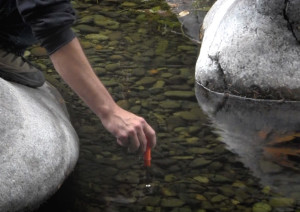 Update Mar 3rd 2016 ~ Over the years, since I first started writing this very strange blog, I have at different times and in different ways, stated that “the story isn’t over”. This was never just a way to avoid ending it. It was rather that throughout all of it, this has been the feeling – that I was in the middle of some unfolding thing, and that in time, the story was going to provide it’s own conclusion. Well… it did. Life being stranger than fiction, this could not have ended much weirder. Did the story come full circle? I would have to say that in a way it did.
Update Mar 3rd 2016 ~ Over the years, since I first started writing this very strange blog, I have at different times and in different ways, stated that “the story isn’t over”. This was never just a way to avoid ending it. It was rather that throughout all of it, this has been the feeling – that I was in the middle of some unfolding thing, and that in time, the story was going to provide it’s own conclusion. Well… it did. Life being stranger than fiction, this could not have ended much weirder. Did the story come full circle? I would have to say that in a way it did.
How to include that ending here, I have no idea. I don’t really know what to make of it at this point. It would in my opinion make for a good twilight zone episode. Perhaps in the future I can make more sense of it… or perhaps I will conveniently forget about the whole thing. That sounds pretty good right now.
Updated Aug 19th 2014
 CLICK HERE for a carvings update.
CLICK HERE for a carvings update.
From July 2008 ~ Recently I came across a story on the internet about a carved stone known as “The Roswell Rock” that had been found in 2004 by a man out hunting in New Mexico. Because of certain of it’s peculiarities he had been encouraged to have it looked at. The lines and shapes of the carving seemed too precise, too perfect, and had the odd appearance that it had somehow been raised up from out of the natural surface of the rock. Experts began examining it and were unable to determine how it could have been carved. It was said that even under a microscope no evidence of tool work of any kind could be found. This in itself was probably enough to make it an object worthy of continued study… but there was more.
Passing a magnet over it would cause either clockwise or counter-clockwise rotation depending on the placement of the magnet. Interesting, but more than that, two dominant elements in the design, tangential circles featuring yin-yanged crescent moons, seemed to be placed precisely on these two rotational pull points. Even more interesting… but it didn’t end there.
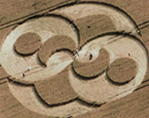 At some point someone noticed that this same design had appeared in 1996 as a crop formation in the UK. Not only was it reportedly a precise match, the two were also apparently inverse opposites,meaning that if they could somehow be scaled to the same size and come together, they would fit as if one had made the other. That is not actually true, but I will explain that issue in detail later.
At some point someone noticed that this same design had appeared in 1996 as a crop formation in the UK. Not only was it reportedly a precise match, the two were also apparently inverse opposites,meaning that if they could somehow be scaled to the same size and come together, they would fit as if one had made the other. That is not actually true, but I will explain that issue in detail later.
aerial image © 1996 by Lucy Pringle. Also see:Cropcircleconnector.com
All of these things; the crop circle design, the rotational pull points, the fact that it was found near the Roswell ufo crash site, and the anomalous look of the carving, all came together easily in peoples minds as indicators that the stone might have an extraterrestrial origin or connection.
As a cautious but avid follower of fringe subjects, I’m quite sure I would have been fully drawn into the intrigue of the story, but as it turned out, I’ll never know what my normal reaction would have been because it probably took less than a few seconds of seeing the photo before I recognized the technique used to carve it, one that I have been using on occasion for 15 years.
The Message Board
The place I initially found the story was the message board of a busy and well known website on which a lively discussion about the stone was taking place. I wanted to jump right in, but knew I would need more than words to back-up my opinion. Being that this was a Saturday, meant that I was going to have to resist posting anything until after I had a chance to get down to the studio where I work and make some kind of sample, photograph it, and then figure out how to put it on the message board. It was a long weekend.
In the meantime I googled the term ” The Roswell Rock ” and saw conversations on message boards all over the place. Speculations, debates, and theories galore. While the “of alien origin” side was trying to figure out its function or decipher the design, the “it’s a hoax” side were throwing out spiteful words about hunks of clay, epoxy resins, and sculpted wax models etc. But no one that I could find, had really figured it out yet.
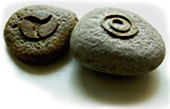 When Monday came, I made a couple of quick samples, and after work, got my 14 year old son to teach me how to post an image. So with that and a couple of brief sentences, I put it up there and thought,”well that’s that”. I felt sad really, that I might be ruining a perfectly good mystery.
When Monday came, I made a couple of quick samples, and after work, got my 14 year old son to teach me how to post an image. So with that and a couple of brief sentences, I put it up there and thought,”well that’s that”. I felt sad really, that I might be ruining a perfectly good mystery.
It didn’t go at all like I had imagined. It was near silence on the board. There were a handful of responses though, some congratulating me for exposing an obvious hoax (I disagree, I don’t think the word hoax applies here), but there were also several along the lines of, “nice work, but yours is not nearly as detailed”. Also there was this, “does yours spin under a magnet?” I didn’t even see it coming. In my own mind I had dismissed the magnet issue. It seemed like a pretty normal attribute for a rock. I didn’t see any point in demonstrating that a rock could spin under a magnet, anybody that felt the need to prove or disprove this could do it for themselves, right? If they wanted more detail though, I could give them that.
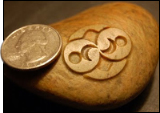 The next day on my lunch I made another one, this time using the 1996 formation’s design.
The next day on my lunch I made another one, this time using the 1996 formation’s design.
This time the reaction was a little stronger and most people were now saying they were convinced, but there were still some bringing up the magnet issue, and I knew that they were really right. I had only done half the job, and knew I wasn’t going to feel right, until I found a magnetic rock and put a crop circle on it.
By the way, I don’t think the term “magnetic rock” is correct. A refrigerator is a thing we stick refrigerator magnets to, but we don’t say the refrigerator is magnetic. There are rocks though, that really ARE magnetic that are known as “load or lodestones”.
lodestone
n : a permanent magnet consisting of magnetite that possess
polarity and has the power to attract as well as to be
attracted magnetically
If someone knows the term (if there is one) for a rock that “can be attracted magnetically” please let me know, I would sure appreciate it – I’m tired of the verbal effort it takes to NOT say magnetic rock.
Finding Rocks that will Rotate (under a magnet)
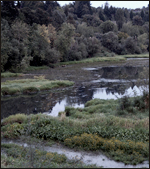 I thought it was going to be a simple matter of visiting the creek near my house, but being new to the area, I hadn’t yet been there and didn’t know that it was really more like a swamp. Walking along an asphalt path through the most “rockless” terrain I have ever seen, I saw no easy way to get to the water itself. If there were any rocks in there I wasn’t about to trudge through the grassy muck to find them.
I thought it was going to be a simple matter of visiting the creek near my house, but being new to the area, I hadn’t yet been there and didn’t know that it was really more like a swamp. Walking along an asphalt path through the most “rockless” terrain I have ever seen, I saw no easy way to get to the water itself. If there were any rocks in there I wasn’t about to trudge through the grassy muck to find them.
After about a mile, just as I was starting to feel like turning back, I found an out of place swatch of small river rocks hiding in the grass under some bushes. So I got out my newly purchased bright orange handled, telescoping, “mechanic’s magnet” and started poking around, trying to behave as best I could like what I was doing was normal so that passers-by would hopefully overlook me. It didn’t work. One girl came right out and asked, “Whats that?” Not being much of a conversationalist, I answered, “it’s a magnet”. Looking at the rocks she then asked “and what are you doing with it?” This was just the kind of surreal exchange I was hoping to avoid. “Finding rocks that are …magnetic…” I said sounding uncertain. Much to my relief she didn’t come back with “why” and instead continued on her walk.
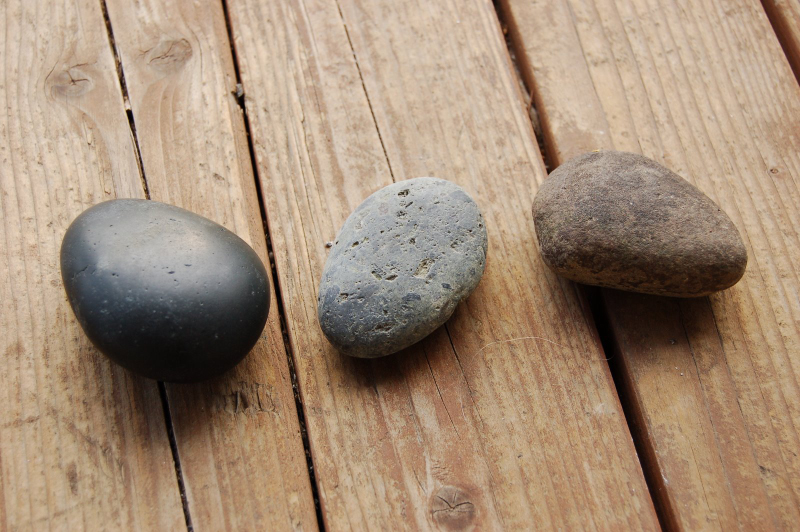 I managed to come away with about twenty rocks that I thought might do the job. As it turned out only three of them would do the turning thing and only the smooth one (on the left) would do it well. Further excursions taught me a lot. Finding rocks that will do this seems to be very much a regional issue. At one point, thinking I had had a stroke of genius, I visited a landscape yard filled with mountainous heaps of variously sized rocks of all kinds – none of which turned out to be at all useful.
I managed to come away with about twenty rocks that I thought might do the job. As it turned out only three of them would do the turning thing and only the smooth one (on the left) would do it well. Further excursions taught me a lot. Finding rocks that will do this seems to be very much a regional issue. At one point, thinking I had had a stroke of genius, I visited a landscape yard filled with mountainous heaps of variously sized rocks of all kinds – none of which turned out to be at all useful.
Exploring the creek several miles upstream turned out to be the answer. There I found that certain banks seemed to collect nothing BUT highly reactive stones while the next bank would have none.
The Way It Works
 So what does it take for a rock that can be magnetically attracted to spin? Its all about shape and nothing more. The bottom should be a nice shallow convexly curved surface, the smoother the better. The other main factor is varying thicknesses of the stone around the balance or “pivot” point and that there is a proportional relationship between the weight of the rock and the pull of the magnet. The latter is in a sense adjustable being that magnets come in a variety of different strengths.
So what does it take for a rock that can be magnetically attracted to spin? Its all about shape and nothing more. The bottom should be a nice shallow convexly curved surface, the smoother the better. The other main factor is varying thicknesses of the stone around the balance or “pivot” point and that there is a proportional relationship between the weight of the rock and the pull of the magnet. The latter is in a sense adjustable being that magnets come in a variety of different strengths.
Basically it works like this. If you hold the magnet over the stone, between the center (pivot point) and the edge, and also between the thick and thin parts, the thicker part is more attracted and also closer to the magnet than the thinner part – so, it rotates toward the magnet. By the way, this is not about perpetual motion – the magnet has to be kept ahead of the turning to get it going. That being said, no two stones are alike, and there are some that are much better for this than others. I have one that seems to come very close to actually “spinning under a magnet” all by itself – but regarding perpetual motion, close doesn’t at all count. Naturally, once you start playing around with magnets and rotation etc, ideas occur, and the next thing you know, you have a big mess in the garage, half a day is missing, and the duct tape is all gone. I shouldn’t go into that right now – but it might make for a good video at some point.
The Art of the Crop Circle
I was really starting to enjoy the creative aspect of what I was doing. Initially, When I felt that urgent desire to get the 96 formation onto a stone as quickly as possible, my only means at the moment was to look at the image on my monitor and actually draw it the old fashioned way – and then using that sketch as reference, draw it again the next day onto a masked rock. This went against twenty plus years of conditioning as a professional artist. When it comes to projects that require speed and accuracy, we typically use modern tools such as printers projectors and plotters. Time is money and the competitive nature of our society dictates how we approach our work. The unfortunate result can be a disconnection with why we are artists in the first place. I’m thankful though that our printer was out of ink that day because, being forced to draw it meant that I was made to study it completely.
Speaking of studying it completely; The observation that has been made about the inverse opposite relationship of the Roswell Rock and the 96 formation is incorrect. It is true that the design on the rock is positive while the one in the field is negative, but to function as opposites they would need to be mirror images. For example, If you press your hands together, palm facing palm, then open them like a book, you can see that they are mirror opposites – the thumb of the left hand is left of its palm while the thumb of the right hand is on the right. Looking at the comparison photos of the rock and the field formation, you can see that they are like two left hands.
To draw one of these correctly, the proportions have to be taken in with an almost chess-like mentality – thinking several moves ahead. The more you look, the more you find connectedness between all of the design’s elements. It was a simple form really, entirely made from circles and parts of circles, but as the eye, hand, and mind work together to find just the right placements and alignments, the cleverness of the design sings right out, loud and harmoniously.
The energy of the experience lured me into the vastness that is crop circle design. For several weeks I went from one formation to the next, drawing them by hand and finding the creative pathways and I felt I was walking in the footsteps of an artistic giant or giant(s). I learned things I could never have learned on my own. For example, I found that an equilateral triangle can be made within a circle by boxing in the circle, and then by dividing the box into 16 smaller boxes, the points of the triangle will fall where the lines of the boxes intersect with the line of the circle.
Inspired by all I was learning, I decided it would be fun and challenging to try to come up with my own design for the one rotational stone that I had found. Three basic things contributed to what I came up with.
1. I wanted it to be like a symbolic instruction manual for spinning the stone.
2. I also wanted it to be a design that would look good while spinning.
3. There were three strong pull points on the rock that I wanted to emphasize.
So basically it needed to be a triangular circle-ish spiral pictogram thing. In retrospect I think the design I ended up with was “OK” in that it had all those things, but what it definitely did not have was that mystical harmony that I was seeing in the crop circles. Eventually, I began to appreciate more and more that much of the power people often perceive in the designs, is directly attributable to geometry itself. Playing with circles and lines will lead you to coincidence after coincidence, pattern-work that just… happens. Formation designers must certainly learn very quickly, that the more adept they become with the mathematics of what they are doing, the more meaningful the designs begin to look.
Back on the board I posted a picture of the resulting stone and a video of it spinning and thought that it would surely suffice and that maybe I was done.
The Investigators
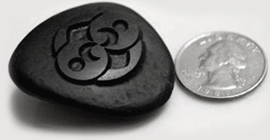 As far as the message board went…. after having met the challenge of ‘do yours spin under a magnet?’ and then a final submission of one more that I considered to be an irrefutable example…. yes – I really WAS done, although nothing I HAD done seemed to have affected much of anything. There were still plenty of discussions going on about how it could have been made, but I certainly wasn’t interested in repeating the process I had just been through on all the different paranormal message boards. How many of them are out there? It could be a never ending crusade – no thanks.
As far as the message board went…. after having met the challenge of ‘do yours spin under a magnet?’ and then a final submission of one more that I considered to be an irrefutable example…. yes – I really WAS done, although nothing I HAD done seemed to have affected much of anything. There were still plenty of discussions going on about how it could have been made, but I certainly wasn’t interested in repeating the process I had just been through on all the different paranormal message boards. How many of them are out there? It could be a never ending crusade – no thanks.
Early on, there had been suggestions from the board that I should send photos of what I was doing to the primary investigator of the Roswell Rock. I got right on it and wondered why I hadn’t thought of that in the first place – it was from that person’s website that the story being discussed had originated. Much to my surprise I was responded to immediately with a couple of questions, one of which was something like, can you try your technique on a sample of iron-rich hard sandstone? I said I would try.
At first, I was unable to come through on the requests. After a few crazy days of trying to fit it in I realized I just didn’t have the time, didn’t know any geologists, didn’t know anyone who knew anybody who knew anything about iron-rich sandstone. I just couldn’t do it. As much as I wanted to, it just wasn’t my part of the puzzle to solve. Soon after though, I sent in the image of the dark stone pictured above, and informed them that, although the thing was very hard, it actually made for an even better carving. Not long after that, in an interview on the radio, I heard that particular investigator report that although someone had sent in photo samples of sandblasted stones, experts were still saying that there was no evidence of any type of “machine” work whatsoever.
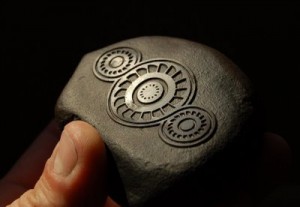 I will always tend to give the benefit of the doubt to the ufologist, the crop circle investigator, the ghost chaser, etc. Studying the ways people operate when confronted with mystery has long been a hobby of mine, and I of course know that it’s unfortunately never as simple as right and wrong, or true and false. As those of us who are compelled (and most of us are) to pick a side, it requires that we mentally dismiss much of what the other side is saying. It’s really the only way we can hope to half-way believe that what we’ve decided is probably the truth …is in any way true. Having watched people dismiss elements of my own life experiences that I consider to be true because it didn’t fit their own understandings has made me automatically sympathetic to the side opposite the skeptic, or the debunker. At the same time though, I believe that for me, it would be unethical not to bring forward information that would bring understanding to something that is clearly being misunderstood, or in some cases, even misrepresented.
I will always tend to give the benefit of the doubt to the ufologist, the crop circle investigator, the ghost chaser, etc. Studying the ways people operate when confronted with mystery has long been a hobby of mine, and I of course know that it’s unfortunately never as simple as right and wrong, or true and false. As those of us who are compelled (and most of us are) to pick a side, it requires that we mentally dismiss much of what the other side is saying. It’s really the only way we can hope to half-way believe that what we’ve decided is probably the truth …is in any way true. Having watched people dismiss elements of my own life experiences that I consider to be true because it didn’t fit their own understandings has made me automatically sympathetic to the side opposite the skeptic, or the debunker. At the same time though, I believe that for me, it would be unethical not to bring forward information that would bring understanding to something that is clearly being misunderstood, or in some cases, even misrepresented.
I thought I had offered the investigators everything they needed, to be able to see that even if aliens DID carve it, they did it with sandblasting. It was not enough. What I was saying was getting dismissed and there was most likely nothing that was going to change that.
At that time, in the “listeners emails” section of the website of Coast To Coast am, an animation appeared, sent in by a listener. It showed the image of the Roswell Rock superimposing itself onto an image of the 1996 formation. The point was made in the accompanying comment that it is an astonishingly exact match. It’s amazing how the mind can see what it expects to see. At first it DOES seem to be quite exact, but this is the result of the eye bouncing around and looking at the parts that DO line up, If you continue to watch the animation though, and look at ALL the parts you will see that there are many that do NOT line up. Some of them are actually pretty far off in my opinion.
Update: I’ve now done my own animated comparison that utterly refutes the assertion that the two are a precise match… take a look at this!
The unspoken point was that the rock and the crop circle were connected in ways other than normal and that this animation was proof. This irritated me quite a bit because, seeing the (apparently hard to perceive) inconsistency between the two was in reality more proof that the two were NOT paranormally linked.
 I knew what I had to do. I wrote up an email, attached images of some of the rocks, and sent it in to Coast to Coast. With the way everything had been going, I wasn’t actually expecting that they would post the images, but boom – up they went! It was a little bit of a shock how fast it happened. One evening, only a day or two after making the submission I went to the website right before one of the shows was about to start, to see who that nights guest was going to be. Just a few minutes later I was back on there for something else and there they were. Remembering that I had given permission for them to show my email address, I popped over there and saw that in just those few minutes there were already 5 responses, and over the next several days there was a steady flow until I had seven pages to deal with. Among those responses was another investigator – Chuck Zukowski of ufonut.com.
I knew what I had to do. I wrote up an email, attached images of some of the rocks, and sent it in to Coast to Coast. With the way everything had been going, I wasn’t actually expecting that they would post the images, but boom – up they went! It was a little bit of a shock how fast it happened. One evening, only a day or two after making the submission I went to the website right before one of the shows was about to start, to see who that nights guest was going to be. Just a few minutes later I was back on there for something else and there they were. Remembering that I had given permission for them to show my email address, I popped over there and saw that in just those few minutes there were already 5 responses, and over the next several days there was a steady flow until I had seven pages to deal with. Among those responses was another investigator – Chuck Zukowski of ufonut.com.
Chuck was nice enough to purchase one of my rocks for his research. I sent him the best one I had at the time, but in the days that followed, my techniques improved and I felt he deserved an upgrade – so I sent him the one that can be seen in the video at the bottom of this page.
Resolved?
The response I got from posting the images on Coast to Coast am’s website was unexpected and a bit overwhelming. The idea that I might have stumbled into a “pet rock”-like opportunity propelled me into a whirlwind of activity.
At that point I was getting closer and closer to what could be called a Roswell Rock replica. Along the way it had evolved from simple sandblasting into so much more. Eventually I was even taking larger stones and cutting them into smaller pieces, then grinding and polishing them down to the right shape and size.
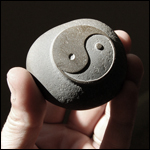 As far as making a true replica, there was still one issue nagging at me. You see – when the design is applied and the surrounding area is blasted away, the new surface is fresh looking, while the protected area of the design still has its aged and natural look. There is, of course, dramatic contrast between the two, much like what can be seen with this yin-yang.
As far as making a true replica, there was still one issue nagging at me. You see – when the design is applied and the surrounding area is blasted away, the new surface is fresh looking, while the protected area of the design still has its aged and natural look. There is, of course, dramatic contrast between the two, much like what can be seen with this yin-yang.
The rock found by Robert Ridge, although having the typical bumpiness that sandblasting causes, does not have the fresh brighter look that would usually come with it. There is no color difference and the sandblasted part also has a peculiar shininess to it. I think it was this unnatural shine on such an obviously textured surface that caused people to be so quick to label it as being fake somehow, even though they often couldn’t quite pinpoint what it was bothering them.
To be made shiny, I would imagine a rough stone surface could theoretically be polished in such a way that the bumpiness would remain, although I personally cannot imagine a way for that to actually happen either by natural or human means. Polishing flattens bumps. (UPDATE – since then I’ve been learning how to polish bumpy surfaces… not as hard as I thought) Similarly, on the issue of color, one could speculate that a rough carved surface’s color matching up so well with it’s uncarved surfaces might indicate that the carving is spectacularly ancient. Very few are going there with this though. I will say that extreme density in a rock yields less contrast from carving, but I’ve never seen it completely absent. So what are we left with?
At first, the only way I was able to somewhat get rid of the freshly sandblasted appearance was to rub it with mineral oil. It worked pretty well for the color contrast, but it also looked, well….”oiled”. Some of the rocks also soaked the oil in so much that the color contrast came right back.
One day I was pondering the problem, when suddenly I remembered reading somewhere that when the Roswell Rock was found, it was caked with dirt, and that Silly Putty was used to clean it. Hmmmm
The closest thing I had on hand was modeling clay. It worked quite well. With a combination of dabbing it with the clay and buffing it with a brush, I was able to get the identical shiny (fake-looking) finish. Eventually I did end up trying silly putty, and it worked even better, as far as getting a more natural look.
Example the no color contrast look by applying “Silly Putty”. (Original Roswell Rock on left, my sample on right)
The amount of interest flooding at me for purchasing the samples was overwhelming, but I felt I needed to come up with an alternative product. To me it seemed that the carving techniques created such an interesting and mysterious look, that there were multiple applications. After all, there is a world of things that could be carved onto a rock – special rocks for special interests. As quickly as I could, I opened an eBay store and named it “Symbols in Stone”, because virtually anything that can be carved onto a rock could be rightfully called a “symbol”. Tentatively I began putting them up for sale. Within that first week I sold enough that I was convinced that it was going to actually pan-out and proceeded to step up production, and why not? It seemed perfect. Now when people contacted me about the images on Coast’s website, asking where they could buy one, I had somewhere I could send them. This was when I found out the disparity between the amount of people who say they want to buy a thing from you, and the actual number that really then buy that thing. As the weeks passed and rocks began to accumulate, on the window sills, on the fridge, the mantel, the piano – and the carvings improved, and the store improved, and even the prices improved, the sales… did not. After two grueling months I sat glassy-eyed before the computer screen, preparing to load images of the latest work, when a simple thought blossomed in my mind. “I don’t have to do this”. Peaceful relief washed over me as I shut down the store.
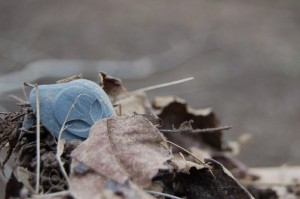 In the end the reward of the effort was managing to do something that many people were saying could only be the work of aliens. How lucky and ironic it was then, that the subject involved is so utterly un-alien – precision stone carving is so old, so fundamentally human… and so it all seems more like the illustration of a symptom of the times in which we live. What are the things that look alien to us, and why? More than anything, perhaps it represents the hectic psychology of a society feeling and fearing it’s own rapid movement.
In the end the reward of the effort was managing to do something that many people were saying could only be the work of aliens. How lucky and ironic it was then, that the subject involved is so utterly un-alien – precision stone carving is so old, so fundamentally human… and so it all seems more like the illustration of a symptom of the times in which we live. What are the things that look alien to us, and why? More than anything, perhaps it represents the hectic psychology of a society feeling and fearing it’s own rapid movement.
There are several things to add especially now that interest has flared up once again, and more people are emailing me about this. The first thing is that, yes I do still have quite a few rock carvings and I do occasionally sell some of them. For the most part though I’m not pursuing rock sales on a regular basis. Stone carving is only a small part of a pretty big array of stuff I do as an artist. On that subject – there are many ideas I’ve had over the years for little stone carvings – I have no doubt these will come into the picture at some point, and I’m really looking forward to that.
Pursuing the possibilities for anomalous looking objects emerging from stone… that is where I’d like to go next. It’s something for the future though. The main focus for the time being is in glass. I did find some really cool rocks yesterday though, one is particularly striking… dark reddish, smooth, yet rugged, and has several distinctive cracks that lend to a very ancient appearance.
A word of warning: There are people out there selling Roswell Rock replicas, but using my pictures to do it. One of these sellers is showing the image of one of my rocks that is still here on my shelf.
If I do sell any, for the time being, it will be from this site. So if you find them on amazon etc – that’s not Glasstone Studio.
Update regarding the conclusions of Chuck Zukowski: I guess it turned out he found my replica to be pretty good, but not good enough. There is reference to the matter on his website, where he says, “Examining the replica next to Robert’s rock showed a tremendous difference not only in precise etching design, but also in non-existing magnetic properties”.
Well, I certainly have a couple things to say about that.
Unfortunately, I was one of the last to hear that the Roswell Rock is allegedly a loadstone. After sending him the samples, I do remember that in a follow-up conversation, Chuck had said that with the Roswell Rock, the magnet at times actually “pushes” it, indicating polarity. Up to that point I hadn’t heard reference to that. Naturally, there would be very noticeable differences between a loadstone and my plain old “iron rich” samples. I had to then ask myself:
do I also need to prove that humans are capable of sandblasting loadstones?
There is something inherently flawed in jumping through each one of these hoops as they appear… at some point it has to stop being about that. Not at all meaning to disrespect Chuck, he is doing one thing, and I am doing another – two completely different things that might seem to go together, but really don’t. Here is video of the actual rock I sent to him, the one he has repeatedly and publicly implied fell so far short.
I don’t presume to “know” anything definitively about the Roswell Rock, except for what I see in the pictures. Whether I can or cannot replicate it perfectly after all is said and done, really proves nothing regarding the question of who made it. The same can be said about anything. I suppose the best and most appropriate comparison would be crop circles themselves, some of the most stunning and impressive crop circles are known to have been human made, but this cannot be said to be proof that aliens don’t do any crop circles. In the end, attempting to answer certain questions becomes a fools errand, but at the same time this doesn’t necessarily mean the questions themselves are foolish.
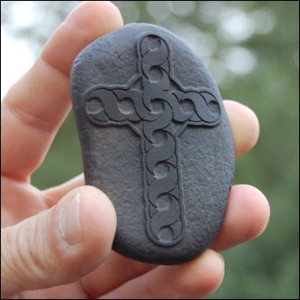 Paranormal investigators like Linda and Chuck are attacked on EVERY question they ask. It is what comes with the territory they are in. They keep at it though, pursuing what they know is there somewhere buried in all the nonsense… hard evidence that we are not alone. I want to assume this about anyone working in that field, that they are there primarily because they believe in what they are doing. To knowingly stand asking questions that virtually guarantee a world of ridicule? I’m not going to pick apart the way they do what they do, and I’m not going to expect them to be able to know every time they are wrong about something.
Paranormal investigators like Linda and Chuck are attacked on EVERY question they ask. It is what comes with the territory they are in. They keep at it though, pursuing what they know is there somewhere buried in all the nonsense… hard evidence that we are not alone. I want to assume this about anyone working in that field, that they are there primarily because they believe in what they are doing. To knowingly stand asking questions that virtually guarantee a world of ridicule? I’m not going to pick apart the way they do what they do, and I’m not going to expect them to be able to know every time they are wrong about something.
There really isn’t much more I can add to the subject, except for perhaps a few high resolution images magnified to show precision, but this is not so much for debating investigators… much more because I like precision stone carving. As far as that goes, I really feel I am just getting started. Working in this experimental way on recreating the Roswell Rock has led me into an area I didn’t even know there was a name for… in the field of glass art it’s called “cold working”. A friend just loaned me a book about it. The chapters feature the various machines involved that are used to engrave, decorate, shape, and polish glass, and it’s like looking at pictures of my own workshop – but even better than that, some of the machines I’m using are NOT in the book.
On the subject of “The Roswell Rock” and its associations with the word hoax: I’d like to stress a few things about this.
There are several distinctly different things going on here, as to why the word hoax is sometimes being used. As a carving, the way that it looks really qualifies it as an optical illusion for the minds eye (especially in certain photos). Relief carving is nothing new – but here, being that it is on a small stone, the first natural mental response can be a kind of confusion that the design has been impossibly raised up from the surface of the rock somehow. Initially and until that point that the mind reconciles the issue in some way, a confusion persists. So the choices for the mind are generally these 1) Figure out how it was carved to your own mental satisfaction 2) See it as a fake, as in not really a rock, “a hoax” 3) Conclude that basically it IS impossible, and is therefore paranormal in nature. 4) Just forget you ever saw it.
It is choices 2 and 3 that are taking people to such diverse opinions, and resulting in such colorful debates on the internet. What I think is so interesting about it is that both directions, as contrasted as they are, lead to some of the most inventive and creative thinking you’ll ever see.
Furthermore, in another way the word hoax can apply, I see no reason to suspect Robert Ridge of anything. I’ve never tried to contact him, and maybe that’s mostly because I just assume him to be telling it like it is. There is nothing so unusual about finding something ‘weird looking’ while out walking. Haven’t we all done that? The story, stripped down to the simple narrative it really is, that of a person out in the middle of nowhere reaching down and picking something up – it is like reconnecting to the best part of childhood… that magical feeling of discovery.
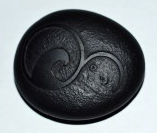 Breaking News: Have a look at this – It appears a man came forward yesterday (8/27/14) with a pretty solid explanation on the actual origin of the Roswell Rock and who made it. This looks to me like the real end of the mystery. I hope the named company will now come forward to confirm… not because I don’t enjoy a good mystery, but because I’m a big fan of the truth when it can be found.
Breaking News: Have a look at this – It appears a man came forward yesterday (8/27/14) with a pretty solid explanation on the actual origin of the Roswell Rock and who made it. This looks to me like the real end of the mystery. I hope the named company will now come forward to confirm… not because I don’t enjoy a good mystery, but because I’m a big fan of the truth when it can be found.
UPDATE: Regarding the Russell images
Image Credit: John Russell, and posted at cropcirclesresearchfoundation.org

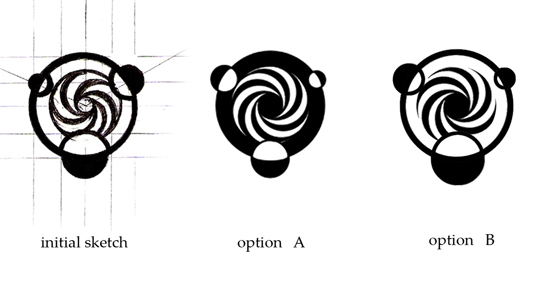









Hi there. I saw a TV episode of ‘Alien Hunters’ or some such thing where they did an in depth analysis of said ‘Roswell rock’ and I can categorically say that it is NOT a lodestone… it MAY have a small chunk of lodestone WITHIN the rock, but considering they did an MRI scan of it and it showed no particular irregularities in it’s throughput composition, I highly doubt it.
It is entirely possible however that a magnetic charge could be imparted to an iron bearing rock either through exposing it to a large magnetic field or via the old ‘stroke’ method where you pass a strong magnet in one direction many, many times giving it a field.
Great job on your part nonetheless and I certainly hope you get the recognition you deserve for showing how, as interesting as this all is, it certainly isn’t the work of aliens. I hope you sell out of all your rocks and think you should market them as ‘alternative art pieces’ complete with a nice little wooden or glass display. Being a limited run of them, sign them and charge a bundle!
On a final note, instead of ‘magnetic rock’, just call them ‘ferrous stones’…. that’s what they are…. iron rich rocks that CAN be affected by a magnetic field! 😉
Sincerely, Mike C.
MIKE! I thought no one was ever going to answer that question. Thank you so much.”Ferrous” – so there is a word for it after all.
That’s interesting – you say it’s actually NOT a lodestone? I was thinking that might be the case. Did they elude to that in the show you watched? I’ll try to find that episode.
Had never heard of the Roswell Rock until I watched the episode you were referring to. Your replica looks spot on with the naked eye and is very impressive. The only thing nagging me is how yours would look under a microscope vs the Roswell Rock. I’m interested to see if you were able to get the same detail and look as this would put the whole thing to rest for me. Thanks for all the information!
-Coleby
On the In Search of Aliens episode devoted to the “Roswell Rock,” an examination of the rock showed that the magnetic effects were overstated — there was a very mild magnetic effect, which could simply be explained by some ferrite content.
Really nice carving technique and well written blog. Cheers
Thanks very much Adam. Colby – I wish I had a microscope… people keep asking about that. Maybe I’ll find one at a garage sale. Terson IV – sounds about right to me.
I want to purchase a replica of the Roswell Rock.
Well written. One thing I could never really find is the meaning of the symbols on the stone. What do they represent or what is the possible meaning? Have other images been found similar or partially similar besides the crop circles ? I am open minded about things like this. You approach this from a different practical angle and I like that. I saw a UFO in the late 70’s in Minnesota, as a teenager living in a Midwest small 320 person farming town we didn’t have exposure to words like UFO or Roswell or flying saucers. It just did not exsist around there. But I saw within the length of 2 football field in a clear bright afternoon sky a flying craft the moved and sped around at speeds so incredible you cannot attach words to describe the event.
So it is refreshing to read detailed no spin view of this object. Thanks for your time and sharing this with those that have found it. I would imagine many people ask about buying an object but don’t understand what the cost represents in time and effort. They expect a cheap imported assembly line internet item. What were you able to sell your works for? I find it interesting more have not purchased from you. They are clearly rare and collectable. Thanks for your time . Great works
Thanks for the comment Tom. I’m very interested in the meanings of symbols. I look at it from a cognitive studies approach. By that I mean that I believe symbols do have real meaning to us at a very deep level – perhaps even to go so far as to say it could be a part of our biological structure in a cerebral sort of way. But that we are, through external societal circumstances, so removed from our ability to understand them, that most of us are probably way off when we try.
However… I recently showed one of the stones to a guy I met down at the local magnet store. Although he had never heard of “The Roswell Rock”, he immediately interpreted the carving to be a perfect symbol for ‘perpetual motion’, which was pretty wild because I hadn’t showed him the spinning thing yet. After talking to him at length, it really seemed like he knew what he was talking about. I find value in rapid intuitive leaps that people can have off of first impressions of things. Insights.
On pricing – they really do vary quite a bit. I’m getting ready to put a bunch of them in the store as soon as I can get them photographed.
The symbol means ” Perpetual Hoax”….Fantastic Article and I saw both Ancient Alien Astronaut Theory episodes. One merely referenced it and another special was specifically on the Roswell Rock altogether. It was the tool mark difference under the microscope that really got you hooked. Then the CT scan reeled you in hook,line and sinker. I still only caught part of the second trick they did with holding the rock in his hand sideways.I thought they did a great job of convincing everyone it wasn’t a fake but there was something odd about the guy who supposedly found it.He carried it with him everywhere he went. Also even more bizzare was the fact that he allowed the scientist to drill down into the rock to get a sample. He didn’t like it BUT he felt it was nessesary to help convince others it was real.To me he acted like a guy who found something very cool,probably sleeps with it and doesn’t look or appear to be bright enough to do this on his own. I think a good “next” step would be to use facial recognition technology to look for those underlying facial expressions that show deceit and lies as you tell your story. These are facial expressions that show if the person had really found it and that he found it there. Homeland security along with the C.I.A. use many of these technologies to get at the truth by slowing down facial expressions one frame at a time.I’m sorry I couldnt think of the correct name off the top of my head. In any case somebody else could have made it and left it there but it seems very doubtful especially along a “Wild game” trail following scat. Please post pictures of your tool work under a microscope for comparison. In either case its Quite fascinating!
I choose to assume Robert Ridge to have found it just as he said he did. I think it’s really important to give people that benefit, that assumption of innocence thing.
The two most common searches that are bringing people to my site are actually questions. Number 1 is: “is the Roswell Rock a hoax?” and number 2 is: “is the Roswell Rock real?”
I hope the work I’ve done here has demonstrated that it almost certainly really is a carved stone.
I’ve always thought the word hoax is the wrong word. The best term I’ve found for it is that it is a “false dilemma”… and the dilemma functions much like a “red herring” for the mind. The interesting thing though is no writer has to frame it to be those things, the rock, as an object, causes the dilemma by the way that it looks. So in that respect, “false” does not mean the same thing as hoax. The Roswell Rock is an accidental false dilemma, which is to say that I believe that whoever made it didn’t try to deliberately make something that people could get “hoaxed” with. If that was the idea, they could have been much trickier about it.
I know this only addresses part of the issue, but it’s the part I’m most interested in.
I question the whole microscope thing… I’ve gone from having no awareness that there is such a thing as “pseudo science”, to where I now look at ALL science with a rapidly developing skepticism. I would have a LOT of questions regarding tool marks. I do intend to look into it when I have time.
Basically though I can say this… if I want to obliterate all tool marks (and I do make tool marks) down to a microscopic level, I can do that… with sandblast. I would not expect to find tool marks on the Roswell Rock though, because it most likely was ONLY sandblasted – It didn’t have to be tooled into the shape that it is – it was already shaped that way.
Thank you for your response. As to the Question about the tool mark. In the episode about the Roswell Rock they took on that exact issue first thing. They made a duplicate and the duplicate was sandblasted.When the two were compared under electron microscope,the two weren’t even close! Even with the best sandblaster in the world it would still be a inferior copy. There must be another way. Something that has been overlooked.I trust you will find it eventually. Once again I commend your work.
I think the symbol from the rock want represents “free energy”. I mean aliens want to express something through such things….and i have seen a episod of “in search if aliens”.In that they said it has various magnetic power to various side….and specially there was more power on symbolic presenatation…..so i think ,it means a representation of magnets in the same way what shown on rock so it will get free energy.
i have not tried this but i think…..i am engineering student….
Just watched the Search for Aliens show about the “Roswell rock”. I thought it was a very nice, very interesting rock, however a rock from an extraterrestrial source was a stretch. Maybe there is another reason the rock is brown (ha ha). Really enjoyed you work (carving and rock finding gathering) and your writing in relation to this topic. Super green production,(fine, noteworthy)carving work, and a very readable writing style. You should consider writing a book or two. Yes, I am a fan of “The Fifth Element”, which features some nifty rock carvings, or at least movie set piece representations of carved rock. When I get my fortune gathered I may check out your store for a rock worthy of display in a case. Cheers, and Merry Winter Holiday season to you and yours. Phil In Renfrew County, Ontario, Canada.
william Carraway,Jr. Said: “When the two were compared under electron microscope,the two weren’t even close!”
You are bringing up something I think I can help people to understand…
The most precise part of the carving is the result of the stencil. Precision is its natural byproduct. This pertains to that upper most surface of the carving, (which was “the original” surface level of the rock). If you think of the edge of the carving like a little vertical wall, the top of the vertical part is very sharp, very precise, but you’ll notice that at the bottom of it, it is more rounded, not so precise… even on the Roswell Rock, parts of that lower edge are VERY rounded right? Other parts are quite sharp.
The sharpness at the bottom of that vertical edge is determined by the depth OF the carving and the angle the sandblaster used to carve it. On the Roswell Rock, the degree of sharpness varies from very sharp, to completely rounded. You don’t need a microscope to see that.
A person sandblasting can achieve that sharpness at the bottom of the depth completely by accident, and a person who knows all about how to achieve that sharpness can also fail to achieve it under certain circumstances.
If I remember correctly, didn’t they just basically compare a sharp part of the Roswell rock to a not sharp part of the other one? Correct me if I’m wrong but – it didn’t really look like a view through a microscope did it? If it was, it was only a couple times magnified.
A further example: Notice on the Roswell rock that the little circles next to the moons are very rounded in their depth, almost like they were scooped out with a little spoon. This is how sandblasting looks when you carve THAT sized circle TO THAT DEPTH. If you were to continue sandblasting beyond that depth, (shooting straight at the circle) eventually you will have carved a perfectly cone shaped hole. However, if you change the angle you are carving at in just the right ways, you can basically carve cylindrically downward and right through the rock.
This whole Ancient Aliens show and talk is such baloney!!!
They lie and fabricate all the time and use a fraud like Sitchin to claim “ancient text” were used, when the fraud Sitchin didn’t know Sumerian!
ANCIENT ALIENS DEBUNKED NEEDS TO AIR ON THE HISTORY CHANNEL!
I read and enjoyed most of the Sitchin books (many years ago). I think the theory presented is fascinating, but I also felt he never went far in supporting it. Always hoped to find a good “alternative opinion” as far as Sumerian cuniforn tablet interpretations. Any recommendations?
hey ..there is nothing in case pf presice work on a roswell rock….i m just surprising of “how this rock can have magnitised?” ..puma panku is the good example of precise work…there is nthing new now……there was great technology to cut a smallest as well largest object with precise in ancient…..now this time is tp know why aliens are coming???
I’d recommend reading about the concept of rotating magnetic fields. Nikola Tesla adapted the idea from Arago who basically applied the principle of eddy currents. Using that notion Tesla patented dynamos and motors that produce and transmit the electricity so ubiquitous in today’s world. I’d say that the rotating stone has that same principle in common. Of course, Tesla is said to be of alien origin by those with a New Age bent but people will believe their exotic thoughts regardless of the era. Madame Blavatsky still has many acolytes!
I think that the way the the carving was ultimately proven to be manmade is a great example of how the UFO mystery should be approached. Instead of lumping hundreds of reports as a way of “proving” UFOs are of ET origin, a major UFO case should be dug deep into to get to the heart of it. In other words no stone left unturned (pardon the phrase…). If someone of high rank says something extraordinary, it doesn’t mean that it’s true – even if he believes it’s true. Where are the real investigators?
I am not convinced it is not an artifact. The Mystery Stone of Lake Winnepesaukee, New Hampshire found in 1872 was labeled an artifact, because of the lack of new technology to precisely carve rock in those days. The Rosewell Rock of New Mexico can be disproven due to our new era. I am researching egg shaped stones and rocks that are being found. Thanks for your research. http://en.wikipedia.org/wiki/Lake_Winnipesaukee_mystery_stone
Great article in so many ways. I would like to see the details of how you mask rocks for sand blasting. It sounds rather labor intensive. I would think the easy way to do this is with a laser engraving machine. No mask required. I also think it would be interesting to try chemical (acid) etch. Also, if you have a stone which reacts to a magnet, I would think you could induce it to behaving like a load stone by simply putting it in a strong magnetic field for a period of time. That should be as simple as making a coil with 1) large enough windings to allow the stone to be place inside 2) Large enough gauge wire to handle the current you plan to throw at it 3) Enough windings to make the field you want. This is simply a matter of how much money you want to spend. So in summary, to go into production, use a laser so it is much less labor intensive to engrave, and magnetize the results.